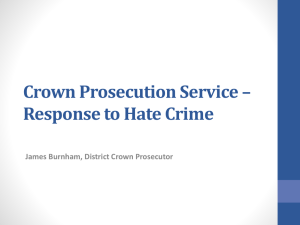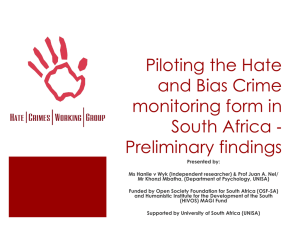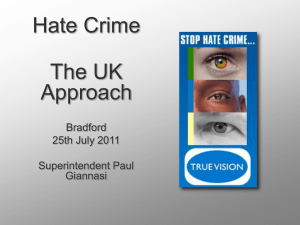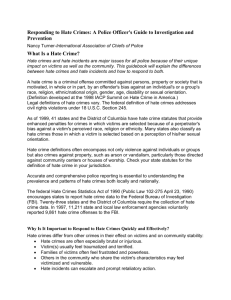hate crimes
advertisement
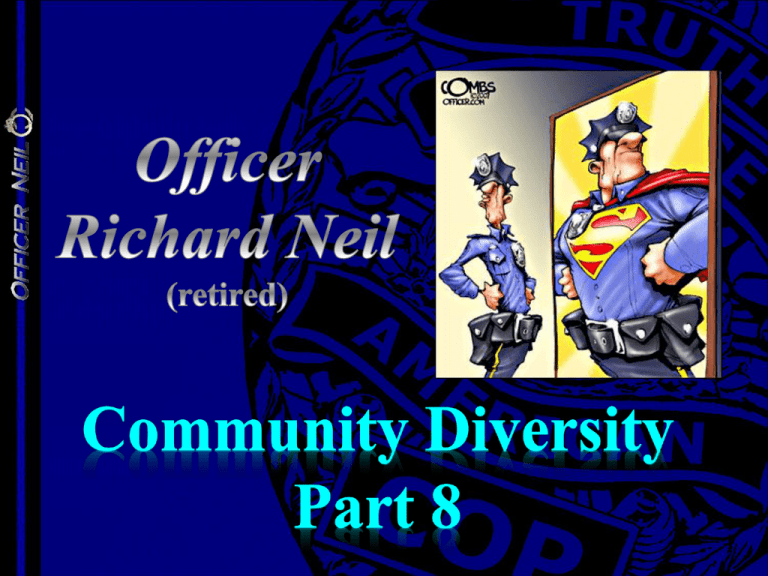
HATE CRIMES TO DISLIKE PASSIONATELY OR INTENSELY TO HAVE AN EXTREME AVERSION TOWARD ANOTHER PERSON, IDEA, OR OBJECT Problems caused by hate crimes Hate crimes demand a special response from law enforcement and civic leaders – These crimes merit a priority response because of their special impact on the victim and the victim’s community – Hate crimes may effectively intimidate other members of the victim’s community, leaving them feeling isolated, vulnerable and unprotected by the law – Traditionally, victims have not received special attention or assistance Problems caused by hate crimes Acts are too frequently dismissed as “pranks” or ordinary cases of: – Vandalism – Criminal damaging – Assault – Harassment – Menacing Effective responses by police to crimes motivated by hate are essential to prevent their spread HATE CRIMES PLACE BASIC FREEDOMS OF AMERICAN SOCIETY IN JEOPARDY Right to Right to Right to Right to individual liberty equality of opportunity religious expression freedom of association In Ohio, a perpetrator commits a hate crime if he or she intentionally selects the victim “by reason of” the victim’s race, religion, color or national origin. Hatred is not an element of the crime. ANY UNLAWFUL ACT DESIGNED TO FRIGHTEN OR HARM AN INDIVIDUAL BECAUSE OF HIS OR HER RACE, RELIGION OR NATIONAL ORIGIN ETHNIC INTIMIDATION LAW IN OHIO ORC 2927.12 No person shall, by reason of the race, color, religion or national origin of another person or group of persons, violate the following sections of the Revised Code: – 2903.21 – Aggravated menacing – 2903.22 – Menacing – 2906.06 – Criminal Damaging or Endangering – 2909.07 – Criminal Mischief – Division (A) (3) (4) or (5) of 2917.21 – Telecommunications Harassment Division (A) (3) 2917.21: Prohibits any person from committing Aggravated Menacing during a telecommunication Division (A) (4) 2917.21: Prohibits any person from knowingly stating to the recipient of a telecommunications that the caller intends: – To cause damage to, or – Destroy public or private property, or – The recipient, any member of the recipient’s family or – Any other person who resides at the premises to which the telecommunications is made, owns, leases, resides or works in will – At the time of the destruction or damaging, be near or in, has the responsibility of protecting or insures the property that will be destroyed or damaged Division (A)(5) 2917.21: Prohibits person from knowingly making a telecommunication to: – The recipient of the telecommunication… – To another person at the premises to – – – – which the telecommunication is made or To those premises… The recipient or Another person at those premises previously has told the caller not to make a telecommunication to those premises or To any other person at those premises Whoever violates section 2927.12, Ethnic Intimidation, is guilty of ethnic intimidation, which is an offense of the next higher degree than the offense the commission of which is a necessary element of Ethnic Intimidation No person shall, by reason of the race, color, religion or national origin of another person or group of persons, violate the following sections of the Revised Code: – 2903.21 – Aggravated menacing – 2903.22 – Menacing – 2906.06 – Criminal Damaging or Endangering – 2909.07 – Criminal Mischief – Division (A) (3) (4) or (5) of 2917.21 – Telecommunications Harassment FEDERAL RELIGIOUS VANDALISM ACT Makes it a Federal crime to intentionally damage or destroy any religious real property because of the religious character of the property where the loss exceeds $10,000 The law also punishes anyone who intentionally obstructs by force or threat of force any person in the engagement of that person’s free exercise of religious beliefs Special emotional and psychological impact on the victim and his/her community Can increase racial, religious, gender and sexual orientation tensions Can lead to reprisals by others in the community thereby escalating violence and turmoil If officers fail to make an effective response or respond in ways that demonstrate a lack of concern, perpetrators may interpret the inactivity as official sympathy or even sanction The impact of being a crime victim is traumatic The impact of being a victim to a hate crime is compounded by the idea of being targeted for race, religion, gender or sexual orientation The importance of effective law enforcement response to hate crimes Reduces fear and anger; facilitates recovery of victims, witnesses and the community Convinces victims and the community that law enforcement takes their concerns seriously Tells actual and potential offenders that such crimes will not be tolerated Mitigates the potential for “copy cat” behavior The importance of effective law enforcement response to hate crimes Reduces the potential for retaliation Generates trust and goodwill between the community and the police department Increases the police department’s credibility Increases law enforcement officer pride and satisfaction in his/her job The presence of visible symbols of hatred and bias The victim’s report as to what the perpetrator said and did Absence of any other motive NATURE OF THE PERPETRATOR The majority of hate crime perpetrators are young people A compilation of arrest records from the entire U.S. document that most hate crimes are committed by persons under 21 years of age More likely to be committed by groups than individuals NATURE OF THE PERPETRATOR The rise in hate crimes parallels the rise in the number of young people joining hate organizations 1988 - 1500 members of the Skinheads in 12 states 1993 - 3500 members of the Skinheads in 40 states 2008 FBI Statistics-Hate Crimes Intimidation accounted for 48.8% Simple assaults 32.1% Aggravated assaults 18.5 percent. Seven murders were reported as hate crimes 3,608 crimes against property 17.7 percent consisted mainly of robbery, burglary, theft, and arson NATURE OF THE PERPETRATOR In 2000, nearly – 65% of hate crime offenders were White – 19% were Black – 5% were multiracial – 14% were of Asian-Pacific Island origin – 1% was Native American and – 10% of the offenders were unknown. 2008 FBI Statistics-Hate Crimes 61.1% were white 20.2 % were black 11% were of an unknown race 31.9 percent of hate crimes took place in or near homes 17.4 percent took place on highways, roads, alleys, or streets 11.7 percent in schools and colleges 6.1 percent in parking lots and garages 2008 FBI Statistics-Hate Crimes 11.7 percent in schools and colleges 6.1 percent in parking lots and garages 4.2 percent in churches, synagogues, or temples There were 105 anti-Islamic incidents reported in 2008 One-tenth the amount of anti-Semitic incidents, which totaled 1,103 Ten questions an investigating officer might ask to confirm that the victim was intentionally selected because of his/her race, religion, color or national origin 10 QUESTIONS Is the victim different from the suspected perpetrators with regard to: – Race – Religion – National Origin – Color Did the incident occur because of this difference? 10 QUESTIONS Did the victim recently move into the area and is his or her family the only one or one of just a few families of their racial, ethnic or religious groups in the neighborhood? What is the victim’s relationship with his or her neighbors and/or local community groups? 10 QUESTIONS Has the victim experienced past or repeated incidents of a similar nature? Was the victim put into a state of fear by the incident and did the perpetrator commit the crime with the goal of creating such fear? 10 QUESTIONS Is there a connection between the date of the incident and the holidays, special programs or events? Is an organized hate group indicated in the incident? – Is hate literature involved? – Is there suspected hate activity in the area? 10 QUESTIONS Does the MO signify a “copycat” syndrome that might be the result of media coverage of other similar incidents? Were there any recent occurrences in the community or incidents reported in the media in which a member of the group to which the victim belongs, making this a “payback” or “revenge” incident harmed member of the offending group? OTHER INDICATORS Bias related comments, written statements or gestures made by the offenders Bias related drawings, markings, symbols or graffiti left at the scene of the incident Objects or items that represent the work of organized hate groups VICTIMS OF HATE CRIMES EXPRESS FIVE NEEDS To feel safe To feel that people care To receive assistance Redemption Retaliation VICTIMS OF HATE CRIMES EXPERIENCE DEEP EMOTIONAL STRESS THAT IS HEIGHTENED BY FEELINGS OF: Fear Terror Personal violation Degradation Refer victim to individuals or organizations that can provide support and assistance, such as victim assistance agencies Court-affiliated Community-based Social service organizations Clergy in the victim’s religious denomination or religious preference Legal services They must rescue any victims and/or administer appropriate emergency care They must prevent any further contamination if chemical weapons are involved They must prevent further casualties They must protect the scene from the standpoint of evidence They must endeavor to identify victims, witnesses, evidence and suspects while the crime scene is still “fresh”


